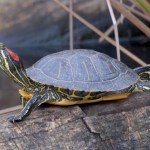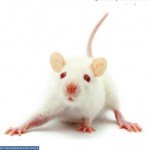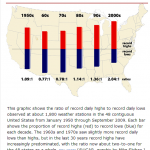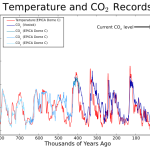temperature
Image of a genetically obese mouse (left) from Wikipedia.
To deal with cold environments, mammals have several options. They could produce heat by increasing metabolism or shivering or they could conserve heat by constricting blood vessels in their skin or snuggling with a friend or insulating materials. With this in mind, researchers wondered how varying levels of insulation (obesity, fur) in mice affected heat loss and how much energy the animals used to maintain body heat. Their thinking was that more insulation would prevent heat loss and lower energy…
Don't let their small size fool you. Tardigrades, or 'water bears', are really tough animals. According to a review published in the American Scientist, these microscopic invertebrates can survive extreme variations in temperature from near absolute zero (-459 deg F) up to +302 deg F. They can also tolerate pressures that are 6 times greater than the deepest ocean, exposure to ionizing radiation (UV and x-ray) and the vacuum of space, as well as exposure to carbon dioxide and monoxide, nitrogen and sulfur dioxide. What's more, they can survive nearly…
An illustrative graphic from Bloomberg.com arrived in my inbox. As they put it: "We just obliterated another heat record."
To view it, you'll have to head over to here: 2015 Was the Hottest Year on Record by a Long Shot
Photo of a red-eared slider turtle by Nightryder84.
Dr. Thane Wibbels (University of Alabama at Birmingham) is interested in studying how temperature affects the sex of red-eared slider turtle embryos. For humans, the answer is simple: sex chromosomes. You know, the combination of XX means girl and XY means boy.
Turtles are not that simple. Temperature is a factor in determining whether the embryo will be male or female. If the eggs are incubated at 78.8 degrees F, the hatchlings will all be male. If they are incubated at 87.8 degrees, they will all be female. As I'm sure you've guessed,…
Some interesting new research. The paper is, unfortunately, behind a paywall but they made a video, so it is worth posting.
Here's the press release for the paper:
Scientists know that temperature determines sex in certain reptiles—alligators, lizards, turtles, and possibly dinosaurs. In many turtles, warm temperatures during incubation create females. Cold temperatures, males. But no one understands why.
A recent study sheds further light on this question. The findings of researchers Kayla Bieser, assistant professor at Northland College, and Thane Wibbels, professor of reproductive biology…
Dear Readers,
Find below an interesting press release I may as well share verbatim:
The rapidly melting ice sheets on the coast of West Antarctica are a potential major contributor to rising ocean levels worldwide. Although warm water near the coast is thought to be the main factor causing the ice to melt, the process by which this water ends up near the cold continent is not well understood.
Using robotic ocean gliders, Caltech researchers have now found that swirling ocean eddies, similar to atmospheric storms, play an important role in transporting these warm waters to the Antarctic coast—…
Shivering is one mechanism by which heat is produced in the body. Heat production is called thermogenesis. Another mechanism is through nonshivering thermogenesis regulated by brown fat (i.e. adipose). This second type of heating mechanism kicks in when we need extra heat production such as a postnatal infant, someone developing a fever, an animal arousing from hibernation, eating, or in the case of the current study, stress.
A recent study published in the American Journal of Physiology provides evidence that during stressful events brown adipose tissue can elevate body temperature through…
So, the bad news is that it is looking increasingly likely that the world will experience a very strong El Nino event this 2014-2015 winter (winter in the N. hemisphere, summer down under). There is even talk of a super-El Nino, one to rival 1998's phenomenal event. Lots of good information on that here at P3. Some forecasters are now putting the odds at 70%.
Model ensemble predictions showing a coming El Nino
The repercussions for global and regional weather are very large, there will be winners and losers, though as with climate change impacts in general, the wins are…
In the last few months, as the severe California drought has garnered attention among scientists, policymakers, and media, there has been a growing debate about the links between the drought and climate change. The debate has been marked by considerable controversy, confusion, and opaqueness.
The confusion stems from the failure of some scientists, bloggers, reporters, and others to distinguish among three separate questions. All three questions are scientifically interesting. But the three are different in their nuance, their importance to policy, and their interest to politicians and water…
[Update: it seems clear that records were broken after all as has been pointed out in the comments. So we are only left with Fox's reaction and youtube fog-pee videos. And let's face it, Fox's reaction was pretty predictable...]
The recent cold snap was indeed remarkable and the media was buzzing about it for days. But it was not remarkable for the extreme cold, which in fact set no records, it was remarkable because it has become so unusual.
Unlike the recent heat waves in the US, Australia, Russia and Europe, this cold snap did not, repeat did not set any all time monthly or daily…
The latest in a long series of science summaries on climate change from the Intergovernmental Panel on Climate Change (IPCC) has just been released. While the report has a massive amount of information in it, related to a wide range of geophysical implications of climate change, here are some of the key water-related findings for precipitation, evaporation, glaciers, ice mass, and more. While many other findings are reported that have hydrologic implications (such as all the findings related to temperature and warming), I have not usually included them here. Definitions of the confidence of…
Watch the video below and see if you can see where the warming stops:
(seen at the wonderful APOD site)
A commenter on the most recent edition of het's AWOGWN asks an interesting set of questions:
How would temperature data have been seen during the last 10,000 years prior to the peak of each of the previous Milankovich cycles? What caused the temperature to reverse course in those cycles and why would we not expect it to occur again this time?
First, here are the quick answers to those three questions, then some discussion. 1. It is not currently possible to resolve the temperature record that long ago to anything close to what we have today. 2. The cause of the temperature…
"The radiation left over from the Big Bang is the same as that in your microwave oven but very much less powerful. It would heat your pizza only to -271.3°C, not much good for defrosting the pizza, let alone cooking it." -Stephen Hawking
One of the most powerful predictions of the Big Bang -- the fact that our cold, star-and-galaxy-rich, slowly-expanding Universe came from a hot, dense, much more homogeneous state -- was the existence of a bath of leftover radiation that should be detectable, even today.
Image credit: Pearson / Addison Wesley, retrieved from Jill Bechtold.
Back when the…
(image info and credits)
Fake skeptics of anthropogenic global warming love to set up the straw man that mainstream climate science believes that CO2 is the one and only driver of climate change. They can then use it in many different attacks, such as gee whiz isn't it stupid that they haven't even thought of the sun's influence. This is of course patently false as even the most cursory survey of actual scientific content will quickly reveal. This straw man is also an implicit part of the argument that the "16 year pause" in global warming proves that CO2 is not a climate…
One of the reasons that climate change is such a big issue is because the global climate is an integral part of the Earth’s entire ecosystem, tied to so many of the big and little things that society cares about. Figuring out how all these complicated pieces tie together is hard, as is linking these pieces together in the minds of the public so that we – and our policy makers – can grasp the true implications of a changing climate and plan for them. Because this is so important, I expect that many of my future posts here will address this issue, but let me start with one example: the…
Reports that researchers elicited a temperature "lower than absolute zero" might make one question the meaning of the word absolute. On Built on Facts, Matt Springer writes "temperature is a relationship between energy and entropy, and you can do some weird things to entropy and energy and get the formal definition of temperature to come out negative." Usually collisions between atoms ensure that less than 50% of atoms in a sample are excited, no matter how much heat you add. But Springer analogizes "What if I start with a huge pile of ground-state atoms, and one by one I…
Researchers at the Weizmann Institute of Science have fostered chemical reactions at "one hundredth of a degree above absolute zero," analogous to conditions in interstellar space. By merging two parallel beams of ultra-cold atoms, scientists kept them sedated enough for quantum behavior. Chemical reactions "took place in peaks, at specific energies – a demonstration of the tunneling that occurs when quantum particles act as waves." While quantum chemistry is new, physicists have been chilling individual atoms for years—thanks in part to the work of new Nobel laureate Dave Wineland. On…
"As far as we can discern, the sole purpose of human existence is to kindle a light in the darkness of mere being." -Carl Jung
During the daytime, light is plentiful and abundant, and the majority of our waking lives are optimized for that. But more and more of us are active late into the dark hours, when -- as Owen Pallett (formerly Final Fantasy) would tell us -- the last of
Your Light is Spent.
Unfortunately for us, our bodies are accustomed to certain types of light during the day, and expect a different type of night at light.
Image credit: TableTop Studio Ltd or LLC.
Because…
August sea ice extent in the Arctic this year was 640,000 square kilometers below the previous record set in 2007. It is also already a record monthly low for any month, though that record will not last as it is going to be broken this September when the lowest extent of the year is normally reached. In less than the last two months, multi-year ice declined by 33% and the oldest ice (over 5 years) declined by 54% (and that ice ain't coming back). While the unusual Arctic Cyclone probably had a noticeable impact on the evolution of this year's (still deepening) record ice loss, it…






